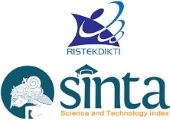Jumputan Batik as a Tourism Creative Product In Sambirejo Village, Prambanan, Yogyakarta
Abstract
ABSTRACT
The purpose of this research is to analyze the potential of creative tourism products that can be used as a characteristic of Sambirejo Village. Jumputan Batik is one of the creative tourism products as a solution in the globalization era, which is derived from the creativity of Sambirejo villagers to meet the needs of tourists and increase tourist visits. The research is located in Rumah Batik Pak Jay Gedang Bawah Sub-Village. The data collection method was carried out by observation directly to the field and in-depth interviews with one of the Jumputan Batik craftsmen Pak Jay or Pak Mujimin who also served as Secretary of Sambirejo Village and other informants based on certain criteria in accordance with the focus of the research. The data analysis in this research is using descriptive analyses. The results showed that Jumputan Batik handicrafts can be developed into tourism creative products or souvenirs that can be marketed to tourists. Not only useful in terms of the economy for the local community, but tourists can also get a new experience by participating in the making of Jumputan Batik. Stakeholders also participated in mentoring tourism creative product potential development activities in Sambirejo Village. The potential of creative tourism products in Sambirejo Village is not only Jumputan Batik, but vegetable chips and souvenirs from natural stone waste can also be developed to the maximum.
Keywords : Jumputan Batik, Tourism Product, Creative Industry, Creative Tourism
Keywords
Full Text:
PDFReferences
Ali, F., Ryu, K., & Hussain, K. (2016). Influence of experiences on memories, satisfaction and behavioral intentions: A study of creative tourism. Journal of Travel & Tourism Marketing, 33(1), 85-100.
Atmojo. (2015). Learning Which Oriented On Local Wisdom To Grow A Positive Appreciation Of Jumputan Batik (Ikat Celup Method), Jurnal Pendidikan IPA Indonesia JPII, 4(1): 48-55.
Blapp, M., & Mitas, O. (2018). Creative tourism in Balinese rural communities. Current Issues in Tourism, 21(11), 1285-1311.
Booyens, I., & Rogerson, C. M. (2019). Re-creating slum tourism: Perspectives from South Africa. Urbani izziv, 30(supple), 52-63.
Bungin, B. (2007). Penelitian kualitatif: komunikasi, ekonomi, kebijakan publik, dan ilmu sosial lainnya (Vol. 2). Kencana.
Diana, Putri et.al. (2017). Peran Dan Pengembangan Industri Kreatif Dalam Mendukung Pariwisata Di Desa Mas Dan Desa Peliatan, Ubud. Jurnal Analisis Pariwisata 17 (2): 84-91.
Gega, B. K., & Pulido-Fernández, J. I. (2016). Policies and Skills for Creative Tourism in Emerging Destinations of the Adriatic. Driving Tourism through Creative Destinations and Activities, 138.
Gunawan, J. (2015). Qualitative online interview in nursing: Concerns and questions. Belitung Nursing Journal, 1(1), 1-3.
Handoyo, Joko Dwi. (2008). Batik dan Jumputan. Yogyakarta : PT. Macanan Jaya Cemerlang.
Handayani, Nur Tri. (2016). Kain Jumputan Karya H. Udin Abdillah di Palembang. Skripsi. Institut Seni Indonesia. Surakarta.
Hudson, S., Hinch, T., Walker, G., & Simpson, B. (2010). Constraints to sport tourism: A cross-cultural analysis. Journal of Sport & Tourism, 15(1), 71-88.
Hung, W. L., Lee, Y. J., & Huang, P. H. (2016). Creative experiences, memorability and revisit intention in creative tourism. Current Issues in Tourism, 19(8), 763-770.
Ihamäki, P. (2012). Geocachers: The creative tourism experience. Journal of hospitality and tourism technology.
Kamil, A. (2015). Industri Kreatif Indonesia: Pendekatan Analisis Kinerja Industri. Jurnal Media Trend, 10(2): 165-182.
Moleong, Lexy J. (2012). Metodologi Penelitian Kualitatif. Bandung : PT Remaja Rosdakarya.
Ningsih, Rini. (2013). Mengenal Jumputan Batik. Yogyakarta: Adicita Karya Nusa.
Prakoso, Aditha Agung. (2019). Strategi Pengembangan Pariwisata Kreatif Berbasis Masyarakat (Communitybased Creative Tourism) Di Bintan. Journal of Tourism Creativity 3(2): 101-114.
Rachão, S., Breda, Z., Fernandes, C., & Joukes, V. (2019). Food tourism and regional development: A systematic literature review. European Journal of Tourism Research, 21, 33-49.
Richards, G. (2009) Creative tourism and local development. In: Wurzburger, R., Pattakos, A. and Pratt, S. (eds) Creative Tourism: A global conversation. Santa Fe: Sunstone Press, pp. 78-90.
Richards, G. (2011). Creativity and tourism: The state of the art. Annals of tourism research, 38(4), 1225-1253.
Richards, G. (2020). Designing Creative Places: The role of Creative Tourism. Annals of Tourism Research 85 (2020) 10292.
Sugiyono. (2012). Memahami Penelitian Kualitatif. Bandung: Alfabeta.
Stamboulis, Y., & Skayannis, P. (2003). Innovation strategies and technology for experience-based tourism. Tourism Management, 24(1), 35-43.
Walker, M., Kaplanidou, K., Gibson, H., Thapa, B., Geldenhuys, S., & Coetzee, W. (2013). “Win in Africa, With Africa”: Social responsibility, event image, and destination benefits. The case of the 2010 FIFA World Cup in South Africa. Tourism Management, 34, 80-90.
Yunia, Dwie et.al. (2019). Pembuatan Jumputan Batik di Desa Kalikatir. Jurnal Penamas Adi Buana 2 (2): 33-38.
DOI: https://doi.org/10.17509/jithor.v4i1.32214
Refbacks
- There are currently no refbacks.

This work is licensed under a Creative Commons Attribution-ShareAlike 4.0 International License.
eISSN : 2654-4687
pISSN : 2654-3893
This work is licensed under Creative Commons Attribution-ShareAlike 4.0 International License














